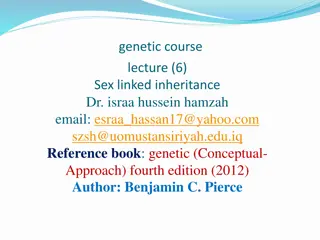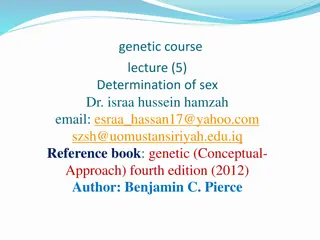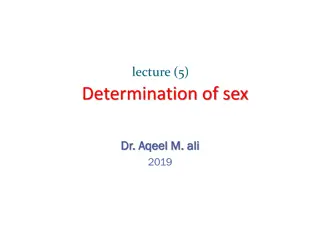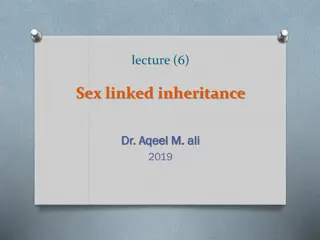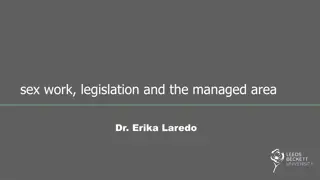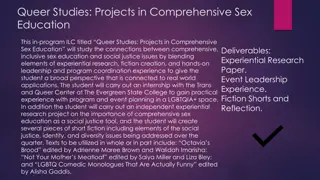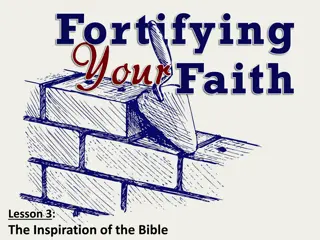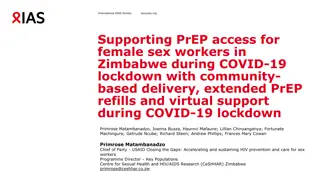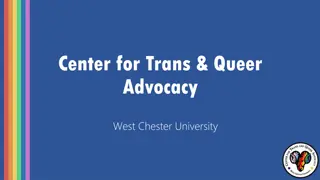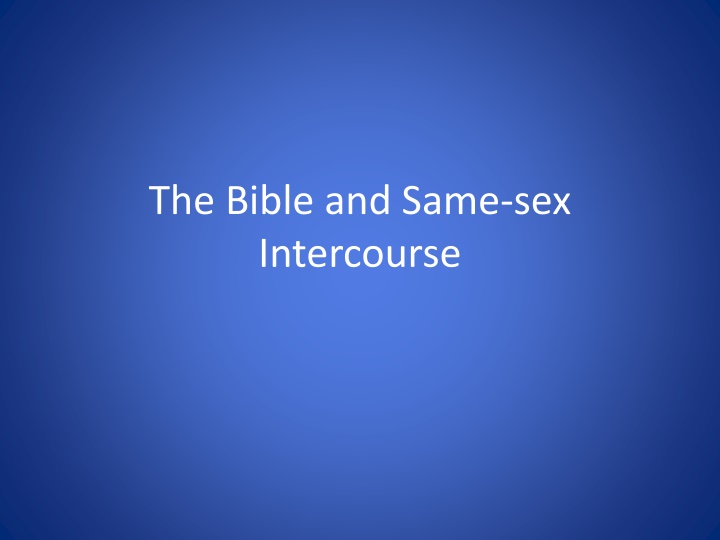
Understanding the Bible and Same-Sex Intercourse
This discussion aims to explore the basis for the Christian church's stance on same-sex intercourse, address common misconceptions, and present differing viewpoints in a well-informed manner. The presenter, a supporter of traditional teachings while advocating for civil rights, discusses the importance of exegesis and hermeneutics in understanding the issue within Western Christianity. The day's plan includes presentations on text analysis, table discussions, and summaries to foster a comprehensive dialogue.
Download Presentation

Please find below an Image/Link to download the presentation.
The content on the website is provided AS IS for your information and personal use only. It may not be sold, licensed, or shared on other websites without obtaining consent from the author. If you encounter any issues during the download, it is possible that the publisher has removed the file from their server.
You are allowed to download the files provided on this website for personal or commercial use, subject to the condition that they are used lawfully. All files are the property of their respective owners.
The content on the website is provided AS IS for your information and personal use only. It may not be sold, licensed, or shared on other websites without obtaining consent from the author.
E N D
Presentation Transcript
The Bible and Same-sex Intercourse
Purpose of the Day To promote well-informed discussion of the issue by: 1. exploring the reasons why the Christian church has heard Scripture as prohibiting same-sex intercourse, i.e. the exegetical and hermeneutical rationale of the teaching 2. correcting some common distortions of the teaching among its supporters 3. accurately and respectfully, but not uncritically, representing alternative opinions
Important Things not attempted A primarily pastoral response A scientific analysis of why people have particular orientations/experience particular sexual attractions An analysis of how this issue relates to Covenant polity
Who am I in relation to this issue? A supporter of the church s traditional teaching, but who also welcomes much of the recent emphasis in western society on civil rights for sexual minorities. A New Testament scholar who does not think exegesis of individual texts alone is sufficient to settle the issue, but does think it is essential and that discernment is impossible without it A Christian concerned by the cultural captivity of both the conservative and progressive wings of western Christianity.
Who am I in relation to this issue? I presuppose neither decline nor progress: Since the coming of Christ and the giving of the Holy Spirit no new events have happened that are decisive for human salvation. We live in a time between the times, a period in which all times are equidistant from God: the modern Western world is not necessarily nearer to God nor, we should make clear against conservative predilections for declinist nostalgia, necessarily any further from God than any other period of history Song, Covenant and Calling, 98.
Plan for the Day 1. Presentation on Exegesis of Texts (9.30 - 10.30) 2. Table Discussion (10.30 11.00) 3. Presentation on Hermeneutical Strategies and Frameworks (11.00-12.00) 4. Lunch (12.00 12.45) 5. Table Discussion (12.45 -1.30) 6. Summary (1.30 2.00
Plan for the Day The reason dividing our time between exegesis and hermeneutics is this: We will look at 3 hermeneutical approaches, of which 2 very largely accept traditional exegesis of the texts we will look at. They are more arguments about how we move from ancient text to contemporary context that arguments than we have misunderstood the texts.
Part 1 Exegesis of Texts
Texts not Treated Genesis 19:1-29 (Sodom and Gomorrah): not relevant (about violent inhospitality and gang rape) Jude 7: refers back to Genesis 19 1 Timothy 1:9-10: the same term used as in 1 Cor. 6:9
Remaining Texts 1. Leviticus 18:22, 20:13 2. 1 Corinthians 6:9 3. Romans 1:26-27
Leviticus 18:22, 20:13 22You shall not lie with a male as with a woman; it is an abomination. (Lev 18:22 NRS) 13If a man lies with a male as with a woman, both of them have committed an abomination; they shall be put to death; their blood is upon them. (Lev 20:13 NRS) Context: These prohibitions are commands not case law. Lev. 18:1-5 signals a concern with the Israelite s sexual practices in relation to the Lord s identity and their identity as the Lord s holy people.
Why is same-sex intercourse an abomination? Traditional Position The unqualified character of the prohibitions in Lev. 18:22 and 20:13 intimates a more fundamental problem with homosexual intercourse than mere status: a distortion of gender itself, as created and ordered by God. Gagnon, The Bible and Homosexual Practice, 142
Why is same-sex intercourse an abomination? Traditional Position These Levitical texts are believed to come from the same priestly source as the creation accounts of Genesis 1. Complex processes lie behind the composition of the Pentateuch but by NT times the Pentateuch was seen as a whole Whether the authors of the early code had the creation stories in mind once the writings were seen as a whole, the probability existed that a reading of the creation stories might inform the reading of the prohibitions. Gagnon argues, not implausibly, that this would have been in the minds of the biblical authors, at least at the final stages of production. Loader, The New Testament on Sexuality, 27
Why is same-sex intercourse an abomination? BUT, the Levitical texts themselves do not make a direct connection to the creation accounts. They simply do not answer the question why. IF the traditional position has merit then we would expect connections to the creation accounts to show up in NT texts facing the same issue.
What about alternative explanations? The Leviticus texts are concerned with Israelite purity in relation to surrounding cultures (e.g. the concern with Canaanite religion in Lev. 18:21). Could the prohibition be related to Canaanite temple prostitution, so that a particular kind of same-sex intercourse is prohibited ? Evidence for male cultic prostitution in Canaanite religious practices is now disputed.
What about alternative explanations? If the texts concern purity, might the issue be ritual impurity only (not ethical), in which case the actions prohibited are only blameworthy if rites of cleansing are neglected. But this does not adequately account for these instructions, since they are not about inevitable impurity (discharge of semen, menstruation, childbirth) and come also in the context of clearly moral prohibitions, such as adultery and bestiality (18:20, 23). Loader, New Testament on Sexuality, 24.
What about alternative explanations? Could the concern motivating the prohibition be focused on honor/shame dynamics , i.e. that a male is dishonored by being penetrated like a woman? This is part of the cultural logic of sexual relations in many ancient cultures, but the biblical writers never express it. The prohibitions in Leviticus are expressed from the perspective of the male penetrating another male, not that of a male allowing himself to be penetrated.
The Leviticus Texts in Second Temple Judaism We have little discussion of the issue in texts of Palestinian provenance but several discussions in diaspora Jewish texts. These texts give various explanations of why same-sex intercourse is prohibited, but all take the prohibition as general. Same-sex intercourse is something Gentiles practice, but not Jews.
Questions for Discussion 1. What are the strengths and weaknesses of the arguments for taking the Leviticus texts as offering something other than a general prohibition of same-sex intercourse? 2. How important is the fact that Second Temple Jewish texts understand the prohibition of same-sex intercourse as general?
1 Corinthians 6:9-11 9Do you not know that wrongdoers will not inherit the kingdom of God? Do not be deceived! Fornicators, idolaters, adulterers, male prostitutes, sodomites, 10thieves, the greedy, drunkards, revilers, robbers-- none of these will inherit the kingdom of God. 11And this is what some of you used to be. But you were washed, you were sanctified, you were justified in the name of the Lord Jesus Christ and in the Spirit of our God. (1Co 6:9-11 NRS)
Translation Issues The NRSV translates very poorly here (male prostitutes, sodomites) and it is not the only English version to do so. The two terms the Paul uses that are translated this way (malakos) (arsenokoit s) The second of these terms is not attested before 1 Corinthians.
The Traditional View Malakos means soft and can be used in a variety of contexts. It is often, but not always, a derogatory term, especially when applied to men, where it signifies effeminacy. There is wide agreement that in relevant contexts it refers to the male who is penetrated (takes the woman s role) in same sex intercourse. Arsenokoit s: Most scholars accept that the word is drawn directly from the LXX of Lev 18:22 and 20:13, both of which have the words ars n and koit (adjacent to each other in 20:13, arsenos koit n). The meaning is almost certainly men who lie with men and refers to the male who penetrates another man in same-sex intercourse.
The Traditional View Leviticus 18:22 (LXX): . Do not have sexual relations ( ) with a man ( ) as one does with a woman; that is detestable. Leviticus 18:22 (LXX): You shall not lie [in bed] ( ) with a male ( ) as with a woman; it is an abomination. The noun Paul uses in 1 Cor 6:9 reflects the verbal usage of the LXX when translating the Leviticus texts.
The Traditional View We should understand 1 Cor 6:9 thus: Do not be deceived: Neither the sexually immoral nor idolaters nor adulterers neither the penetrated nor the penetrators in sexual intercourse between two males ( ) Paul here refers to both partners in sexual intercourse between two males and in doing so reflects the general prohibition of same-sex intercourse found in Leviticus. Paul also had Leviticus in view when condemning incest (1 Cor 5), where the relevant texts would be Lev. 18:6-8).
What about alternative explanations? Perhaps Paul means to prohibit not all sexual intercourse between two males but particular morally repugnant kinds of same-sex intercourse: Malakos can refer to a male prostitute. It is this kind of same-sex intercourse to which Paul objects. See Scroggs, New Testament and Homosexuality, 107-08. Arsenokoit s can refer to some kind of economic exploitation by sexual means. See Martin, Sex and the Single Savior, 43.
What about alternative explanations? These terms have broad semantic ranges. Words often can be used in different ways and its has to be determined from context which meaning is intended. How do we know what Paul intended here? On either side how do we know that we are not simply picking them meaning most favorable to what we already believe on other grounds?
What about alternative explanations? A Traditionalist Answer: These terms are here used together and have to be interpreted together The alternative explanations fail to reckon with the close connection with the vocabulary of the LXX in Lev. 18 and 20 As a Second Temple Jew if Paul meant to do something other than prohibit all same-sex intercourse he would need to explain why If you use general terms without specification then they are reasonably to be taken in a general way. Alternative explanations pick a specific, limited meaning without any contextual indication that this is intended.
What about alternative explanations? On balance, then, Paul probably uses the two terms with reference to men who engage in same-sex behavior, with the first referring to the willing passive partner, whether by private consent or as a male prostitute, those who submit to sexual penetration by other men, and the second referring to those who engage in sexual penetration of other men, which would have a broader reference and include, but not be limited to, exploitation, also by force. Loader, The New Testament on Sexuality, 321-22.
A Different Kind of Alternative Explanation Paul does generally prohibit same-sex intercourse between two males in 1 Cor 6:9, but the characteristic form of same-sex intercourse in Graeco-Roman society is pederasty (adult male with adolescent male) and this is very different from contemporary advocacy for consensual, loving, lifelong same-sex marriage: Almost all the documents discussing male same-sex eroticism assume a distinction between active older men and passive younger males in other words, the practice of pederasty. Brownson, Bible, Gender, Sexuality, 274.
A Different Kind of Alternative Explanation Two points to be noted: Big age gaps are characteristic of male-female marriages in the ancient world. Girls marry shortly after puberty. There is a danger of applying anachronistic definitions of abuse. What is meant by almost all ?
A Different Kind of Alternative Explanation Thomas Hubbard, Homosexuality in Greece and Rome: A Sourcebook of Basic Documents (447 primary source excerpts, 167 of which are from the imperial period) [Megilla]: I was born as a woman like the rest of you, but my mind, desire, and everything else in me are that of a man (Lucian, Dialogue of the Courtesans, 5:4) [Roman astrology]: If the Sun and Moon are in masculine signs and Venus is also in a masculine sign in a woman s chart, women will be born who take on a man s character and desire intercourse with women like men (Matheseos libri viii 7.25.1) Famous Consensual Same-Sex Couples: Agathon and Pausanias, Achilles and Patroklos, Emperor Hadrian and Antinous (though Hadrian was married to Sabina), Emperor Galba and Icelaus, and the woman-woman couple of Megilla and Demonassas. For further discussion, see Sprinkle, Paul and Homosexual Behavior, 501-04.
Questions for Discussion Which interpretation of Paul s terms do you find most convincing? Does 1 Cor 6:9 refer generally to the active and passive partners in same-sex intercourse or not? Is 1 Cor 6:9 alone clear enough to establish what the NT teaches about same-sex intercourse?
Romans 1:26-27 26For this reason God gave them up to degrading passions. Their women exchanged natural intercourse for unnatural, 27and in the same way also the men, giving up natural intercourse with women, were consumed with passion for one another. Men committed shameless acts with men and received in their own persons the due penalty for their error. (Rom 1:26-27 NRS)
Pauls Argument in Context Romans 1:18-32 sets up a homiletical sting operation. The passage builds to a crescendo of condemnation, declaring God s wrath upon human unrighteousness, using rhetoric characteristic of Jewish polemic against Gentile immorality. It whips the reader up into a frenzy of indignation against others: those unbelievers, those idol- worshippers, those immoral enemies of God. But then in Romans 2:1 the sting strikes: Therefore you have no excuse, whoever you are, when you judge others; for in passing judgment on another you condemn yourself, because you, the judge, are doing the very same things. The reader who gleefully joins in the condemnation of the unrighteous is without excuse (anapolog tos) before God (2:1) , just as those who refuse to acknowledge God are anapolog tos (1:20). The radical move that Paul makes is to proclaim that all people, Jews and Gentiles alike, stand equally condemned under the just judgment of a righteous God. Hays, The Moral Vision of the New Testament, 389.
Pauls Argument in Context We have already charged that all, both Jews and Greeks, are under the power of sin, righteous, not even one; there is no one who seeks God. (Rom 3:9-11 NRS) 10as it is written: "There is no one who is 11there is no one who has understanding,
Pauls Argument in Context Whatever Paul prohibits in Rom 1:26-27, his Jewish readers will readily recognize as sinful and characteristically Gentile (like idolatry) Whatever Paul prohibits in Rom 1:26-27 exemplifies (is a symptom of) what is true of everyone. It does not establish a heterosexuality that is righteous and a homosexuality that is unrighteous. All our sexualities are fallen. There is no such thing as a straight person (reflecting appropriately God s intentions as creator for human sexuality) in biblical terms. Whatever Paul prohibits in Rom 1:26-27, he does not say that judgment will fall upon those who engage in such acts but that the existence of such acts demonstrates the alienation of humanity from God and therefore the reality of judgment
Pauls Argument in Context Paul characterizes sin as an enslaving power. As such, sin is not just transgression where we choose to do what we know is wrong. The power of sin impacts us so that we come to desire the wrong things (Rom. 7:8). Our transgressions result in a loss of freedom. The power of sin affects human judgment (Rom 1:21) Paul is certainly not characterizing what we would call same-sex orientation/attraction as a simple choice.
The Traditional View Rom 1:26 refers to same-sex intercourse between women and Rom 1:27 to same-sex intercourse between men The pairing with idolatry is significant (Rom 1:21-25) because (i) it and same-sex intercourse are Gentile sins, and (ii) it and same-sex intercourse both reject God s intended purpose for humanity as Creator In idolatry humans worship created things (same as them) when they should worship God (other than them), and in same-sex intercourse relate to other men or other women (same as them) when they should relate to the opposite gender (other than them)
The Traditional View 23 And they exchanged ( llaxan) the glory of the immortal God for images They exchanged (met llaxan) the truth of God for a lie, and worshiped and served created things rather than the Creator -- who is forever praised. Amen. 26 Because of this, God gave them over (parad ken) to shameful passions. Even their women exchanged (met llaxan) natural relations for unnatural ones. 27 In the same way the men also abandoned natural relations with women and were inflamed with lust for one another. Men committed indecent acts with other men, and received in themselves the due penalty for their perversion. 28 Furthermore, since they did not think it worthwhile to retain the knowledge of God, he gave them over (parad ken) to a depraved mind, to do what ought not to be done.
The Traditional View When Paul talks about what is natural or unnatural in relation to sexual intercourse, he is referring to the created order. The term physis ( , nature) reflects divine design. Genesis 1 is essential to the logic of Paul s argument: 27So God created humankind in his image, in the image of God he created them; male and female he created them. 28God blessed them, and God said to them, "Be fruitful and multiply, and fill the earth and subdue it; and have dominion over the fish of the sea and over the birds of the air and over every living thing that moves upon the earth." (Gen 1:27-28 NRS)
The Traditional View One can scarcely ignore that for Paul divine creation is a major presupposition of his thought As Nolland puts it, also with reference to the prohibitions of Lev 18:22 and 20:13, Paul is likely to have drawn a line from male and female he created them to the Leviticus texts and gained from this link his confidence that this bit of the law applied to Gentiles as well. Loader, The New Testament on Sexuality, 301-02 quoting Nolland, Romans 1:26-27, 51-52.
Alternative explanations of nature The term physis ( , nature) has a wide semantic range. It can mean other things: 1 Cor 11:14 Does not nature (physis = human custom) itself teach you that if a man wears long hair, it is degrading to him Eph 2:3 All of us also lived among them at one time, gratifying the cravings of our flesh and following its desires and thoughts. Like the rest, we were by nature (physis = disposition) deserving of wrath.
Alternative explanations of nature Nature refers to custom or cultural norms or personal dispositions but not some absolute standard. If today, same sex intercourse is natural or culturally acceptable to people, we should say that Paul s prohibition against unnatural behavior is no longer applicable. Paul s concern in Rom 1:26-27 is not an inversion of created order but something else: Paul clearly condemns same-sex erotic behavior in Rom 1, but not all forms of it. Paul critiques a specific type of homoeroticism that is marked by excessive lust, lack of self-control, and overindulgence. Sprinkle, Paul and Homosexual Behavior, 498 summarizing the excessive-lust view
Excessive Lust? There are plenty of ancient texts that do portray same- sex intercourse as resulting from excessive lust and lack of control. The vehemence of Paul s language suggests he is referring to something excessive and not everyday. 1:27 refers to male same-sex intercourse but 1:26 does not unambiguously refer to same-sex intercourse between women. A literal translation is Even their women exchanged natural relations for unnatural ones. Some Church Fathers take this to refer to perverted desires of women in their sexual relations with men, others to same-sex intercourse.
Excessive Lust? When discussing same-sex behavior ancient writers typically (and as far as I can tell unanimously) used the phrase para phusin ( ) to describe the immoral nature of same-sex eroticism. Sprinkle, Paul and Homosexual Behavior, 509 This is the phrase ( against nature ) used to describe the behavior of women in Rom 1:26
Excessive Lust? Paul never says that males and females exchanged non-lustful sex for lustful sex. Rather, females exchanged males for females, and males exchanged females for males, because ultimately humans have exchanged the Creator for creation. Paul s language of exchange (Rom 1:24, 26, 28) renders the excessive-lust interpretation problematic. Sprinkle, Paul and Homosexual Behavior, 513.
A broader Canvas? Brownson does not use the excessive-lust interpretation by itself, but as one of three strands: Paul envisions the sexual misbehavior he describes as a violation of one s individual identity nature or identity, as a violation of deeply established social norms regarding gender, and as a violation of the biological imperative to bear children. All of this is conveyed in his characterization of these behaviors as unnatural. Brownson, Bible, Gender, and Sexuality, 246.
A broader Canvas? There are exegetical issues with this: The New Testament never expresses concern about male shame in behaving like a woman. The New Testament never directly connects marriage and procreation BUT, Brownson does point us to the issue of cultural distance and change, and hence to hermeneutical questions.
Questions for Discussion 1. Which interpretation best fits the context of Paul s argument? 2. What does against nature mean here in Rom 1:26-27? 3. Is the traditional perspective correct to see Paul s argument as strongly shaped by the creation accounts in Genesis?
Part 2 Hermeneutical Strategies



